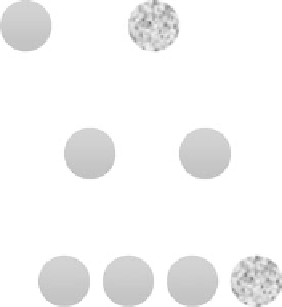Biology Reference
In-Depth Information
of each cross, and his first observations were that the hybrids forming
the F
1
or first filial generation all resembled one of their two parents.
When he crossed round peas with wrinkled peas, for example, the F
1
hybrids were all round, so he called this round characteristic dominant
and the wrinkled characteristic that disappeared recessive.
Mendel then bred a second generation from the hybrid generation.
Interestingly, the parental characteristic that had disappeared in the F
1
generation reappeared in this new F
2
or second filial generation in a ratio
of 3 dominant to 1 recessive. This was true for each of the seven traits
Mendel examined. Figure 3-1 gives a schematic representation of the
experiments. Mendel further observed that while all of the recessive
F
2
individuals would breed true, only one third of the dominant
individuals would breed true, while the remaining two thirds would
give rise to dominant and recessive offspring in the previously observed
3:1 ratio.
From these observations, Mendel came to the conclusion that the
alternative forms of each characteristic were passed along to the
offspring unchanged. He concluded that the alternative forms, which he
called ''particulate factors'' and we now call alleles, were separated or
segregated in the formation of gametes, such that each gamete contained
only one particulate factor (allele) for each character. This idea is called
the Principle of Segregation or Mendel's First Law. The pair of alleles
inherited by the offspring would determine its appearance. A pea
plant with two recessive alleles would have the recessive appearance,
whereas a pea plant with one or two dominant alleles would have the
dominant appearance. Thus, Mendel differentiated between the
appearance of the organism, called phenotype, and its genetic
constitution, called genotype.
Mendel also made crosses between plants that differed in two traits,
such as seed shape and plant height, called dihybrid crosses. He observed
Parental
generation
x
P
only round
peas in
First filial
generation
F
x
1
F
1
Second filial
generation
3:1 ratio of round vs.
wrinkled in
F
2
F
2
FIGURE 3-1.
Diagram illustrating Mendel's pea experiments and results.
















